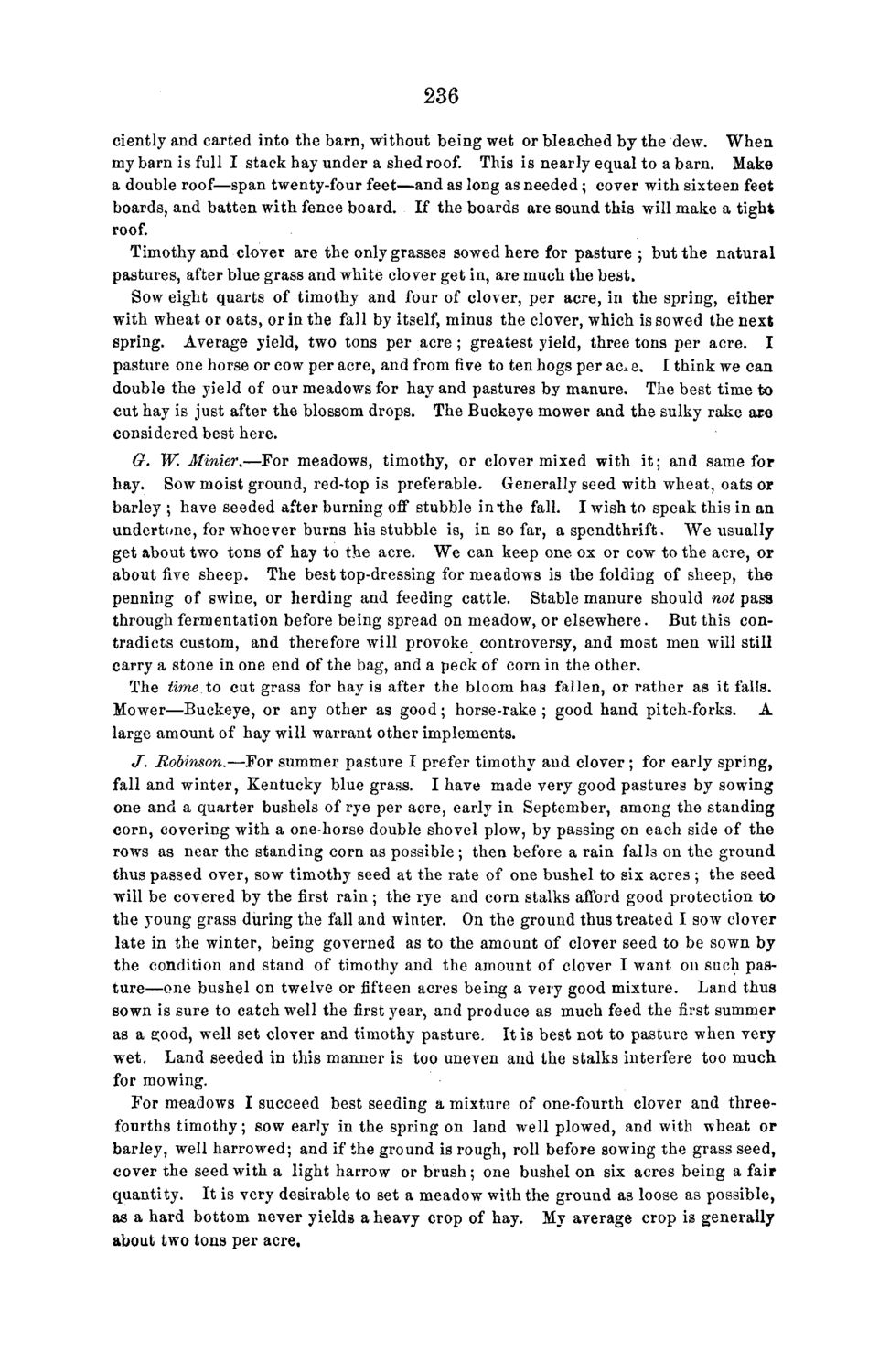| |
| |
Caption: Board of Trustees Minutes - 1868
This is a reduced-resolution page image for fast online browsing.

EXTRACTED TEXT FROM PAGE:
236 ciently and carted into the barn, without being wet or bleached by the dew. When my barn is full I stack hay under a shed roof. This is nearly equal to a barn. Make a double roof—span twenty-four feet—and as long as needed; cover with sixteen feet boards, and batten with fence board. If the boards are sound this will make a tight roof. Timothy and clover are the only grasses sowed here for pasture ; but the natural pastures, after blue grass and white clover get in, are much the best. Sow eight quarts of timothy and four of clover, per acre, in the spring, either with wheat or oats, or in the fall by itself, minus the clover, which is sowed the next spring. Average yield, two tons per acre ; greatest yield, three tons per acre. I pasture one horse or cow per acre, and from five to ten hogs per ac^e. I think we can double the yield of our meadows for hay and pastures by manure. The best time to cut hay is just after the blossom drops. The Buckeye mower and the sulky rake are considered best here. Gr. W. Minier,—For meadows, timothy, or clover mixed with it; and same for hay. Sow moist ground, red-top is preferable. Generally seed with wheat, oats or barley ; have seeded after burning off stubble in the fall. I wish to speak this in an undertone, for whoever burns his stubble is, in so far, a spendthrift. We usually get about two tons of hay to the acre. We can keep one ox or cow to the acre, or about five sheep. The best top-dressing for meadows is the folding of sheep, the penning of swine, or herding and feeding cattle. Stable manure should not pass through fermentation before being spread on meadow, or elsewhere. But this contradicts custom, and therefore will provoke controversy, and most men will still carry a stone in one end of the bag, and a peck of corn in the other. The time to cut grass for hay is after the bloom has fallen, or rather as it falls. Mower—Buckeye, or any other as good; horse-rake ; good hand pitch-forks. A large amount of hay will warrant other implements. J. Robinson.—For summer pasture I prefer timothy and clover ; for early spring, fall and winter, Kentucky blue grass. I have made very good pastures by sowing one and a quarter bushels of rye per acre, early in September, among the standing corn, covering with a one-horse double shovel plow, by passing on each side of the rows as near the standing corn as possible; then before a rain falls on the ground thus passed over, sow timothy seed at the rate of one bushel to six acres ; the seed will be covered by the first rain; the rye and corn stalks afford good protection to the young grass during the fall and winter. On the ground thus treated I sow clover late in the winter, being governed as to the amount of clover seed to be sown by the condition and staud of timothy and the amount of clover I want on such pasture—one bushel on twelve or fifteen acres being a very good mixture. Land thus sown is sure to catch well the first year, and produce as much feed the first summer as a e;ood, well set clover and timothy pasture. It is best not to pasture when very wet. Land seeded in this manner is too uneven and the stalks interfere too much for mowing. For meadows I succeed best seeding a mixture of one-fourth clover and threefourths timothy; sow early in the spring on land well plowed, and with wheat or barley, well harrowed; and if the ground is rough, roll before sowing the grass seed, cover the seed with a light harrow or brush; one bushel on six acres being a fair quantity. It is very desirable to set a meadow with the ground as loose as possible, as a hard bottom never yields a heavy crop of hay. My average crop is generally about two tons per acre.
| |